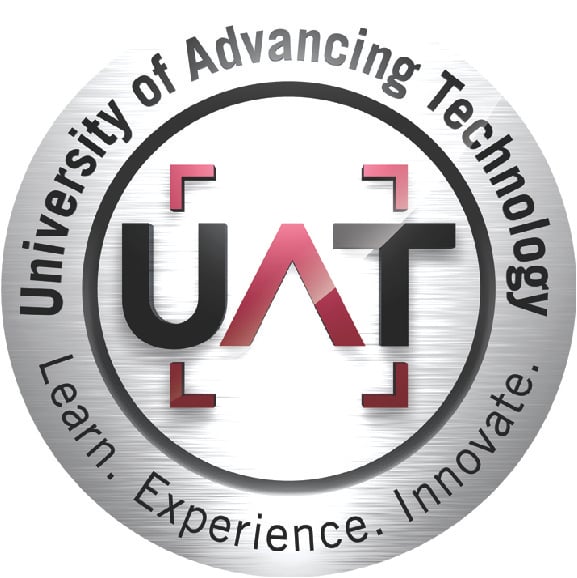What does financial literacy mean? You see articles on high schools graduating students who know math and how to read and write, but they are lacking fundamental life skills, including financial literacy. When many young adults move out, they still don’t know how to budget, pay bills or get insurance.
Professor Derric Clark brought financial literacy to UAT in partnership with Junior Achievement of Arizona. Students were tasked with creating a financial literacy education game for school-aged students with the goal of every school in the Valley having access to this game. The game will be integrated into classrooms to support the financial literacy curriculum schools are teaching.
The team started as a small group of six, but quickly grew to 30 members. After understanding the concept, the group created the game’s identity, theme and style of play.
When deciding the game style, the team addressed restraining forces and the audience. The game needed to work on existing public-school equipment with curriculum approachable for all levels of learners. The team created a Chromebook-compatible game with 200 polies max for every scene. Derric recommended games such as Graveyard Keep and Farmville, which influenced the cartoon-style.
“We wanted to ensure that even though we were trying to put so much educational information into this, it was actually going to be appealing to those playing it, and that it was going to be fun,” says Kieli Adkins.
Tycoonizing the gameplay, having the play constantly manage resources, created the core mechanics. This idea then stemmed many systems mapped by the designers.
The education element was incorporated after the platform was established. After embracing the tycoon aspect, the team needed to decide the type of systems that worked best with educational material. This landed them on interactive gameplay, that plays out as a one-shot take. The play isn’t removed from the experience, which results in the gameplay players as a quest system that delivers education.
To further that, the team implemented an event system within the gameplay for educational moments through minigames. This resulted in all actions being based on visual cues and UI as clicking was solely used for menus and confirmation. Lighting, highlighting objects, particles and player feedback where included in the visual cues. The game also allows for customization, such as customizing the character. C# coding, Unity 2019 and Rider were used to write the game’s code.
Mimicking a slice of life simulator, the minigames are similar to jobs. To earn a paycheck, players must accomplish tasks and allocate resources. The practical utilization of tutorials is used here.
These include maneuvering through a bank account, and learning to budget, pay bills and get insurance.
While this game is meant for K-12 classrooms, it can be played by anyone who wants to learn about finances. And the players aren’t the only learners, the team noted that creating this game was a crash course in finances for them as well, “it’s truly amazing how much you may not know about life skills, every person on this project has learned something throughout this game,” says Justine Grauel.
“My favorite day is sitting down and telling everybody, okay here is a mortgage, here is how you do this. Cause I’ve done it, I had to go through it, but my first time I had no idea what I was doing,” says Derric Clark, “I just had to figure it out as I was doing it because no one ever taught me either.”
Just as it takes a village to raise a child, it’s taken an entire team of UAT students working together to create a much needed, practical educational tool for school kids.
See what our students are working on.
Professor and Lead: Derric Clark
Project Lead: Tyler Ann Cook, MS Game Production and Management, Game Design
Project Manager and Project Lead: Justine Grauel, Virtual Reality, Game Art and Animation
Art Leads:
Jonathan Campbell, Game Design, Game Art and Animation
Kieli Adkins, Game Art and Animation, Game Programming
Andrew Van Winkle, Game Art and Animation
Programming Leads:
Miguel Hernandez, Advancing Computer Science, Virtual Reality, Game Design
Ethan Page, Game Programming
Design Leads:
Tyler King, Game Design
Kyle Davis, Game Design
Alex Schlegel, Game Design
Artists:
Nick Hodes, Game Design, Game Art and Animation
Kenneth Frueh, Game Design
Ruth Luis, Game Art and Animation
Naomi Law-Komegay, Game Design, Game Art and Animation
Ian Favreau, Game Art and Animation
RaLen Watson-Davis, Game Art and Animation
David Schafers, Game Art and Animation
Addison Buettner, Game Design
Sidney McKnight, Game Art and Animation
Justan Griffin-McClinton, Game Design
Jeff Watanabe, Game Art and Animation
James Goddard, Game Art and Animation, Game Programming
Jake Rigsby, Game Design
Daniel McWhorter, Game Art and Animation
Programmers:
Abdulai Sallah, Game Programming
Nathan Scott, Game Programming
James Fisher, Game Programming
Sean Murphy, Game Design
Amanda Kimball, Advancing Computer Science
Designers:
Peter Tibbals, Game Design
Nicholas La Macchia, Game Programming
Tousean Woodard, Game Design
John Kvassey, Game Design, Game Programming
Alex Pabon, Game Design
Business Technology:
Renee Grauberger, Business Technology



Comment